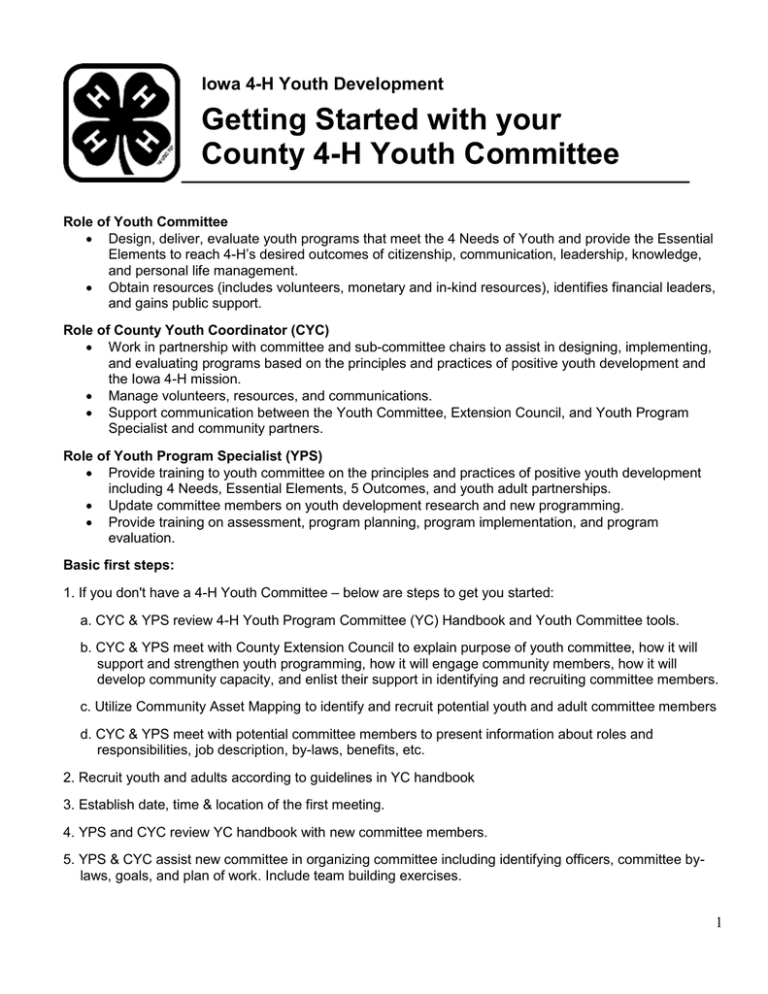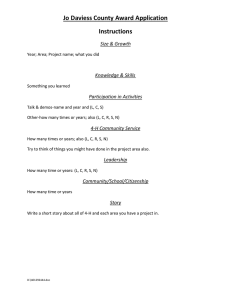
Iowa 4-H Youth Development
Getting Started with your
County 4-H Youth Committee
Role of Youth Committee
Design, deliver, evaluate youth programs that meet the 4 Needs of Youth and provide the Essential
Elements to reach 4-H’s desired outcomes of citizenship, communication, leadership, knowledge,
and personal life management.
Obtain resources (includes volunteers, monetary and in-kind resources), identifies financial leaders,
and gains public support.
Role of County Youth Coordinator (CYC)
Work in partnership with committee and sub-committee chairs to assist in designing, implementing,
and evaluating programs based on the principles and practices of positive youth development and
the Iowa 4-H mission.
Manage volunteers, resources, and communications.
Support communication between the Youth Committee, Extension Council, and Youth Program
Specialist and community partners.
Role of Youth Program Specialist (YPS)
Provide training to youth committee on the principles and practices of positive youth development
including 4 Needs, Essential Elements, 5 Outcomes, and youth adult partnerships.
Update committee members on youth development research and new programming.
Provide training on assessment, program planning, program implementation, and program
evaluation.
Basic first steps:
1. If you don't have a 4-H Youth Committee – below are steps to get you started:
a. CYC & YPS review 4-H Youth Program Committee (YC) Handbook and Youth Committee tools.
b. CYC & YPS meet with County Extension Council to explain purpose of youth committee, how it will
support and strengthen youth programming, how it will engage community members, how it will
develop community capacity, and enlist their support in identifying and recruiting committee members.
c. Utilize Community Asset Mapping to identify and recruit potential youth and adult committee members
d. CYC & YPS meet with potential committee members to present information about roles and
responsibilities, job description, by-laws, benefits, etc.
2. Recruit youth and adults according to guidelines in YC handbook
3. Establish date, time & location of the first meeting.
4. YPS and CYC review YC handbook with new committee members.
5. YPS & CYC assist new committee in organizing committee including identifying officers, committee bylaws, goals, and plan of work. Include team building exercises.
1
6. YPS train committee on meeting Youth Needs, Essential Elements, 5 Outcomes, and youth adult
partnerships.
7. Establish a method of accountability for reporting back on a quarterly basis to the Extension Council.
8. Monitor progress. CYC may attend initial committee meetings, but eventually the committee should be
able to meet on its own so the CYC has time to begin this process with sub-committees.
Sub-committees of Youth Committees
1. CYC, YPS, and Youth Committee identify what sub-committees would be ideal to have to move the
county 4-H program toward its goals.
2. Select 2-3 sub-committees as the highest priority based on committee goals and county action plan.
Develop a sub-committee purpose statement. Determine if it is a standing sub-committee or ad hoc subcommittee. Utilize a committee chair (co-chair) job description, with term limits included.
3. Recruit a youth and an adult to co-chair the sub-committee. Provide them with youth-adult partnership
training if needed.
4. Recruit sub-committee members – they do not need to be a part of the larger YC. Ideally they are other
community members who bring other perspectives and skills to provide leadership and service.
5. Create a method of accountability -- a reporting back system to the 4-H Youth committee.
6. Monitor progress. CYC may attend initial committee meetings, but eventually the committee should
meet on its own so the CYC has time to begin this process with other sub-committees.
Note from Lisa:
When I worked with 4-H Committees in Wisconsin, we built excitement by holding a large “CIA” meeting complete with buttons that said "I'm a member of the 4-H CIA" with a picture of shaded glasses. CIA stood
for "Committees in Action." The sub-committees all had their fall kick-off meeting on the same night in a
large meeting room, which prevented me from being able to run any of the committees and prevented
individuals from being on multiple committees and trying to run the program with their agenda. I addressed
the group and welcomed everyone. They had a certain length of time to work and then every subcommittee reported back to the entire group. It really was energizing to hear all the wonderful work that
each sub-committee was doing and helped people to feel like they were part of a great and awesome
organization.
~ Lisa Berkland, YPS Region 2
Prepared by Lisa Berkland, Chris Gleason, and Brenda Allen Youth Program Specialists
January 2011
Rev. 4/2014
Iowa State University Extension programs are available to all without regard to race, color, age, religion, national origin, sexual orientation, gender identity, genetic
information, sex, marital status, disability, or status as a U.S. veteran. Inquiries can be directed to the Director of Equal Opportunity and Compliance, 3280 Beardshear
Hall, (515) 294-7612.
Issued in furtherance of Cooperative Extension work, Acts of May 8 and June 30, 1914, in cooperation with the U.S. Department of Agriculture. Cathann A. Kress,
director, Cooperative Extension Service, Iowa State University of Science and Technology, Ames, Iowa.
2


